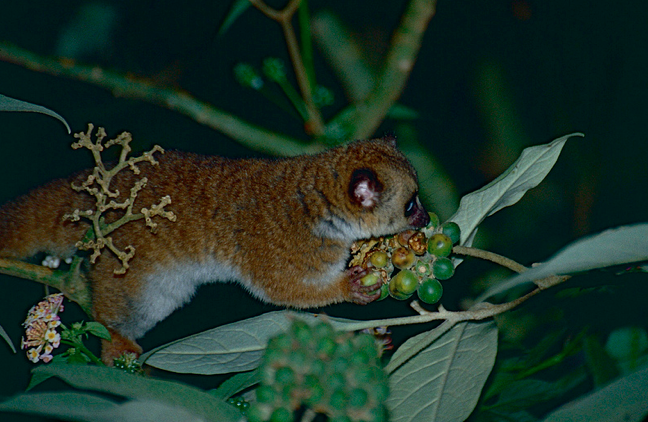The Cheirogaleidae are the family of strepsirrhine primates containing the various dwarf and mouse lemurs. Like all other lemurs, cheirogaleids live exclusively on the island of Madagascar.
Characteristics

Cheirogaleids are smaller than the other lemurs and, in fact, they are the smallest primates. They have soft, long fur, colored grey-brown to reddish on top, with a generally brighter underbelly. Typically, they have small ears, large, close-set eyes, and long hind legs. Like all strepsirrhines, they have fine claws at the second toe of the hind legs. They grow to a size of only 13 to 28 cm, with a tail that is very long, sometimes up to one and a half times as long as the body. They weigh no more than 500 grams, with some species weighing as little as 60 grams.[3]
Dwarf and mouse lemurs are nocturnal and arboreal. They are excellent climbers and can also jump far, using their long tails for balance. When on the ground (a rare occurrence), they move by hopping on their hind legs. They spend the day in tree hollows or leaf nests. Cheirogaleids are typically solitary, but sometimes live together in pairs.
Their eyes possess a tapetum lucidum, a light-reflecting layer that improves their night vision. Some species, such as the lesser dwarf lemur, store fat at the hind legs and the base of the tail, and hibernate. Unlike lemurids, they have long upper incisors, although they do have the comb-like teeth typical of all strepsirhines. They have the dental formula: 2.1.3.32.1.3.3
Cheirogaleids are omnivores, eating fruits, flowers and leaves (and sometimes nectar), as well as insects, spiders, and small vertebrates.[3]
The females usually have three pairs of nipples. After a meager 60-day gestation, they will bear two to four (usually two or three) young. After five to six weeks, the young are weaned and become fully mature near the end of their first year or sometime in their second year, depending on the species. In human care, they can live for up to 15 years, although their life expectancy in the wild is probably significantly shorter.
Classification

Footnotes
- a According to the letter of the International Code of Zoological Nomenclature, the correct name for this family should be Microcebidae, but the name Cheirogaleidae has been retained for stability.[2]
- b In 2008, 7 new species of Microcebus were formally recognized, but Microcebus lokobensis (Lokobe mouse lemur) was not among the additions. Therefore, its status as a species is still




No comments:
Post a Comment
Note: Only a member of this blog may post a comment.